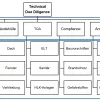Development of a Methodology for Material-Based Screening and Categorisation of Existing Buildings with Regard to the Circular Economy
The thesis deals with the development of an innovative method for the evaluation of existing buildings that goes beyond the traditional technical approach and can be defined as circular due diligence.

Introduction
The aim is to assess building components as reusable resources at the end of their life cycle and thus contribute to improving sustainability and reducing the environmental impact of the construction sector. The method combines the usual technical due diligence, which is well established in the engineering and architecture sector, with different types of analyses aimed at the reuse and recycling potential of materials. In order to optimally handle this complex method, a decision system based on the AHP (Analytic Hierarchy Process) method is used, which simplifies the evaluation of data by comparing criteria in pairs and provides clear and comprehensible results. This step-by-step process is designed to be understood not only by experts, but also by other project participants or potential customers.
Problem definition
The linear economic model based on the 'take – make – throw away' principle is no longer viable for the construction sector, so the transition to a circular model is crucial to reduce the environmental impact of buildings. While this process has already been initiated for new construction projects, the problem persists for existing buildings as there is still no standardised process to include the reuse of materials and components in the assessment. This is due to a number of factors, such as the high complexity of the circular assessment of a building exposed to many impacts over time, the difficulty of reusing materials produced to different standards and the limited knowledge of the building fabric produced in other eras, often long ago. Last but not least, the large number of variables associated with existing buildings poses a problem that further complicates the implementation of an already complex closed-loop system.
Methodology
The methodology starts with the TDD assessment and the CAPEX assessment of the investments required to keep the analysed building functional in the long term. It is crucial to define objectives, alternatives and criteria at an early stage. The technical and economic assessments are complemented by additional environmental and social criteria that also take into account, for example, the resilience of the building or the impact of the materials used on the environment. In a preliminary feasibility study, the possible uses for the building are analysed, including a controlled complete or partial demolition. Subsequently, in a detailed analysis carried out in parallel with the refurbishment project, the possibility of reusing individual components that can no longer be used in the building itself is also analysed. By cataloguing and reintegrating them into the totality of available materials, a closed-loop process is achieved. The process is supplemented in each phase by a prioritisation of the criteria, which is carried out using the AHP matrix system.
City Hochhaus Leipzig case study
The case study analysed concerns the City Hochhaus in Leipzig, which was built in the early 1970s. The analysis was carried out in collaboration with a specialist planning team from Arup in Berlin by applying the described method to a real project. The owner requested a due diligence to assess the possibility of extending the life of the listed building, followed by a refurbishment plan. The extended TDD was supplemented by a feasibility study to investigate the options available, focussing on the renovation of the building envelope, which required significant intervention for building regulations reasons. The detailed implementation of the reclamation audit enabled the integration of the circular methodology, which ultimately allowed a large amount of float glass to be recovered through selective demolition. These measures significantly reduced the environmental impact of the renovation, increased the efficiency of the building envelope and recovered a total of 85 tonnes of high-quality, marketable architectural float glass.
Project participants
1st reviewer
2nd reviewer
Dipl.-Ing. Christian Mueller
Master's graduate
Ilaria Di Benedetto




